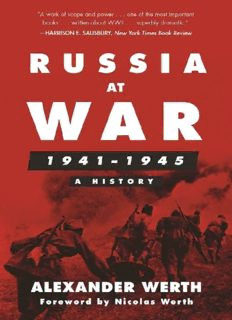
Russia at War, 1941–1945: A History PDF
Preview Russia at War, 1941–1945: A History
PRAISE FOR RUSSIA AT WAR 1941–1945 “Magnificent. … It fills a great void. … the best book we probably shall ever have in English on Russia at war.” —William Shirer, author of The Rise and Fall of the Third Reich “This is not merely a history (although it happens to be an excellent one). It is not a collection of personal reminiscences (although it incorporates many). It is not a scholarly examination of Russia during the critical years 1941–1945 (although it puts under close analysis many events during that period). … [Werth’s] Russian panorama has the depth and vividness of a Vereshchagin warscape. His descriptions of Nazi atrocities … are almost too terrible to read. … [Russia at War] overflows with the contradictory, the half-understood, the mysterious, the impossible to explain. … It bears comparison with William L. Shirer’s The Rise and Fall of the Third Reich as a work of scope and power. … One of the most important books yet written about WWII … superbly dramatic.” —Harrison E. Salisbury, The New York Times Book Review “There is no book in any language with which to compare this monumental but exceedingly readable history of the Nazi-Soviet war … in savagery and hatred it was the biggest war in history … an engrossing and terrifying book.” —Life “Engrossing history … spellbinding narrative.” —Newsweek “Monumental and absorbing. … An epic work that will fascinate the ordinary reader.” —Saturday Review “An illuminating book.” —Elbridge Colby “Alexander Werth was one of the greatest war correspondents of the Second World War.” —Antony Beevor ALSO BY ALEXANDER WERTH: France in Ferment (1934) The Destiny of France (1937) France and Munich: Before and After the Surrender (1939) The Last Days of Paris (1940) The Twilight of France (1942) Moscow ’41 (1942) Leningrad (1944) The Year of Stalingrad (1946) Musical Uproar in Moscow (1949) France 1940– 1955 (1956) The Strange History of Pierre Mendès-France (1957) America in Doubt (1959) The de Gaulle Revolution (1960) The Khrushchev Phase (1961) To the Memory of MITYA KHLUDOV aged 19 Killed in Action in Belorussia July 1944 CONTENTS Foreword Introduction PART ONE PRELUDE TO WAR I Russia’s 1939 Dilemma II The Soviet-German Pact III The Partition of Poland IV From the Finnish War to the German Invasion of France V Russia and the Fall of France—Baltic States and Bessarabia VI Russia and the Battle of Britain: a Psychological Turning-Point? VII Display of Russian Military Might—Molotov’s Tragi-comic Visit to Berlin VIII “1941—it will be a Happy Year” IX The Last Weeks of Peace PART TWO FROM THE INVASION TO THE BATTLE OF MOSCOW I Soviet Unpreparedness in June 1941 II The Invasion III Molotov and Stalin Speak IV Smolensk: the First Check to the Blitzkrieg V Close-Up One: Moscow at the Beginning of the War VI Close-Up Two: Autumn Journey to the Smolensk Front VII Advance on Leningrad VIII Rout in the Ukraine: “Khrushchev versus Stalin” IX The Evacuation of Industry X Battle of Moscow Begins—The October 16 Panic XI Battle of Moscow II—Stalin’s Holy Russia Speech XII The Moscow Counter-Offensive XIII The Diplomatic Scene of the First Months of the Invasion PART THREE THE LENINGRAD STORY I The Dead of Leningrad II The Enemy Advances III Three Million Trapped IV The Ladoga Lifeline V The Great Famine VI The Ice Road VII Leningrad Close-Up VIII Why Leningrad “Took It” IX A Note on Finland PART FOUR THE BLACK SUMMER OF 1942 I Close-Up: Moscow in June 1942 II The Anglo-Soviet Alliance III Three Russian Defeats: Kerch, Kharkov and Sebastopol IV The Renewal of the German Advance V Patrie-en-Danger and the Post-Rostov Reforms VI Stalin Ropes in the Church PART FIVE STALINGRAD I Stalingrad: the Chuikov Story II The “Stalingrad” months in Moscow—the Churchill visit and after III Russians encircle the Germans at Stalingrad IV Stalingrad Close-Ups. I: The Stalingrad Lifeline II: The Scene of the Manstein Rout V Stalingrad: the Agony VI Close-Up: Stalingrad at the Time of the Capitulation VII “Caucasus Round Trip” PART SIX 1943: YEAR OF HARD VICTORIES—THE POLISH TANGLE I After Stalingrad—The Birth of “Stalin’s Military Genius” II The Germans and the Ukraine III Kharkov under the Germans IV The Economic Effort of 1942–3—the Red Army’s New Look— Lend-Lease V Before the Spring Lull of 1943—Stalin’s Warning—The Germans’ “Desert Policy” VI The Technique of Building a New Poland VII The Dissolution of the Comintern and Other Curious Events in the Spring of 1943 VIII Kursk: Hitler Loses His Last Chance of Turning the Tide IX Orel: Close-Up of a Purely Russian City under the Germans X A Short Chapter on a Vast Subject: German Crimes in the Soviet Union XI The Partisans in the Soviet-German War XII Paradoxes of Soviet Foreign Policy in 1943—The Fall of Mussolini—The “Free German Committee” XIII Stalin’s Little Nationalist Orgy after Kursk XIV The Spirit of Teheran PART SEVEN 1944: RUSSIA ENTERS EASTERN EUROPE I Some Characteristics of 1944 II Close-Up I: Ukrainian Microcosm III Close-Up II: Odessa, Capital of Rumanian Transniestria IV Close-Up III: Hitler’s Crimean Catastrophe V The Lull Before D-Day—Stalin’s Flirtation with the Catholic Church—“Slav Unity” VI The Russians and the Normandy Landing
Description: